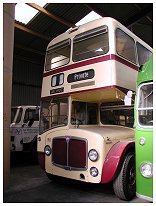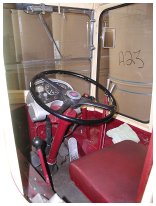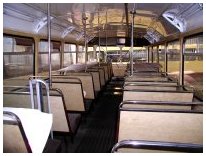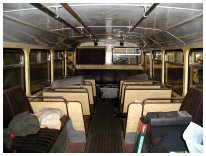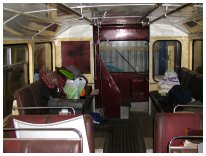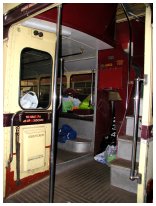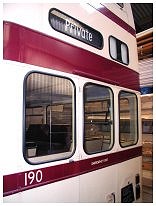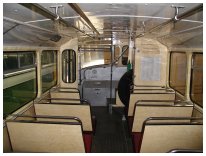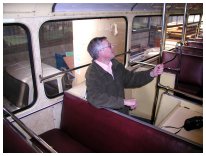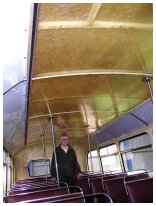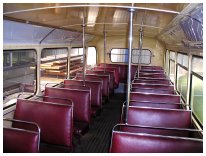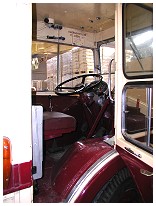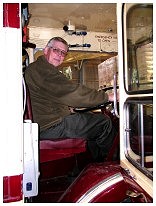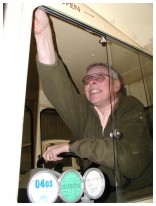5
A visit to see some preserved LCT buses
in March 2003
To view Full Screen, with no toolbars, press and toggle F11
|
Page 1 |
Page 2
| Page 3
| Page 4
| Page 5
|
More LCT on Flickr
|
|
We enjoyed a brief visit to Markfield, my brother and myself, to have a
look at a couple of ex-LCT buses we had both last worked on some 30
years ago. We were there by invitition of Andrew Tucker, Richard
Worman, and John Arnold, and for us to give the group a couple of old
destination blinds that had been gathering dust in my loft these past
30 years. Don't ask, either how I came by them, or why I took the
trouble to take them all the way to Hull with me. John used to work in the bodyshop at Abbey Park Road, long before my time, and so is well-used to the vagaries of destination blinds, how they wear, and how they fit. It was as well, as with no more further ado, he took out the cheap and nasty paper blinds then in the front of 190, and quickly rolled the 1961 quality canvas blinds onto the rollers. We had a good tour round of the buses undergoing restoration, and these photos taken by Jeff are a record of our visit. |
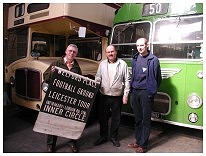 Of course, by this time, we had already done the photo-shot of handing over the new blinds, with the Star of the Show, Bus 190 in the background. As Andy Tucker looks on, John Arnold, (with the mousetache), former bodyshop employee at Abbey Park Road in the late 50s and early 60s, looked very eager to get his hands on these historic objects from the days of his youth . . . |
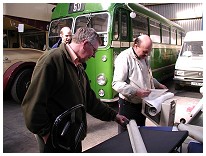 And before I could say "Chief Inspector" or even "White Report", he was
changing them over. I've never seen anything done so fast! We all
helped to roll the 'new' blinds onto the rollers, and I for one was
astonished on the removal of the existing blinds to discover that
they're now made of paper instead of canvas! John was very amused at my
astonishment. But in no time at all, the job was done, and John flew
off upstairs and we looked on increduously as his hands quickly appeared in the destination
compartment, and with the speed and efficiency of an expert, the first
of the new blinds was duly fitted.
And before I could say "Chief Inspector" or even "White Report", he was
changing them over. I've never seen anything done so fast! We all
helped to roll the 'new' blinds onto the rollers, and I for one was
astonished on the removal of the existing blinds to discover that
they're now made of paper instead of canvas! John was very amused at my
astonishment. But in no time at all, the job was done, and John flew
off upstairs and we looked on increduously as his hands quickly appeared in the destination
compartment, and with the speed and efficiency of an expert, the first
of the new blinds was duly fitted. |
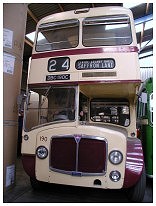 And before I knew it or could catch my breath, would you believe it, they had me back in the cab and changing the bloody blinds again!! This was the hardest day's work I'd done in some time. By the time I was done, I was completely cream crackered ! I need to have a word with my Union Rep. And I need a nurse. My blood pressure is a bit high, as can be seen by my ears glowing like rear lamps. 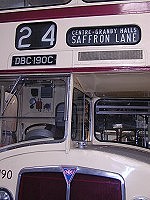 But 190 did look a treat, and a lot more
like an original Leicester bus with the older blinds in - and lifting
the lid, she was
just as nice underneath as well But 190 did look a treat, and a lot more
like an original Leicester bus with the older blinds in - and lifting
the lid, she was
just as nice underneath as well And the significance of the 24 Saffron Lane? The first route I worked as a conductor, in October of 1968. My first day on the road was with Bert Chalmers as my training conductor, and if I recall correctly, the bus was a PD2, and the barrier was right down Rutland Street, outside the church near the old Odeon. A long walk from Humberstone Gate, but of course, soon the new Operating Centre and canteen would be just up the road. Then they moved the 24 into Bowling Green Street at the back of the Town Hall. So happy memories all round. |
All in all, it was a great visit. My thanks to Andy and his lady wife for setting it all up for us,
and Richard and John, and all for making us
so welcome.
And last but not least, thanks to my bruv, Jeff, for taking so many
cracking photos,
without which this page would have been a lot
less fun. Cheers Jeff !
Page 1 | Page 2 | Page 3 | Page 4 | Page 5
Early Bus Memories
a separate page of text,
a child's-eye view of memories of
the Midland Red and LCT buses in the 50s
and then on to memories of the
Corporation Driving & Conducting School
at Abbey Park Road in 1968.
Conducting - how it was done
Another separate page solely on conducting a bus,
more exactly, how it was done on LCT in the late-60s, early-70s,
and in particular by me, and my memories of it.
Duties, shifts, ticket machines, athletic passengers and much more.
Be warned - it is a long treatise.
Rob and Val's Home Page
ARE
YOU IN NEED
of photos being restored?

BRING YOUR OLD
DAMAGED PHOTOS TO LIFE AGAIN!
Do you have any old
photos which are crinkled,
scratched or damaged in any way?
Perhaps after flood or other accidental damage.
Don't throw them away - they can be restored.
Maybe I can help ... see my full page on our
PHOTO
REPAIR
&
RESTORATION
SERVICE
Just click the link or menu button to go to a new page
displaying many before-and-after examples of my work.
military - naval - transport genre photos a speciality
I can also handle slides, both plastic and card mounted,
and negatives, either loose or in strips.
Early Bus Memories
a separate page of text,
a child's-eye view of memories of
the Midland Red and LCT buses in the 50s
and then on to memories of the
Corporation Driving & Conducting School
at Abbey Park Road in 1968.
Conducting - how it was done
Another separate page solely on conducting a bus,
more exactly, how it was done on LCT in the late-60s, early-70s,
and in particular by me, and my memories of it.
Duties, shifts, ticket machines, athletic passengers and much more.
Be warned - it is a long treatise.
Rob and Val's Home Page
of photos being restored?

BRING YOUR OLD DAMAGED PHOTOS TO LIFE AGAIN!
Do you have any old photos which are crinkled,
scratched or damaged in any way?
Perhaps after flood or other accidental damage.
Don't throw them away - they can be restored.
Maybe I can help ... see my full page on our
PHOTO REPAIR
&
RESTORATION SERVICE
Just click the link or menu button to go to a new page
displaying many before-and-after examples of my work.
military - naval - transport genre photos a speciality
I can also handle slides, both plastic and card mounted,
and negatives, either loose or in strips.
